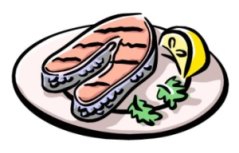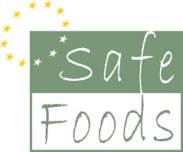1.2.4 An example of an acute dietary risk assessment
In order to understand how an acute dietary risk assessment can be performed and to ascertain whether a food product poses a health risk or not, we will present here an example of the point estimate approach.

We all know that eating fish is very healthy but what happens if in a specific case salmon is contaminated with dioxins?
In the case of dioxins, it is important to estimate the chronic (long-term) exposure of the compound. For this, it is necessary to estimate, based on consumption data, the daily consumption of salmon.
Let’s imagine that our national consumption database indicates that the average person consumes 500 g of salmon per week, resulting in a daily consumption of:
500 g salmon / 7days = 71 g/day = 0.07 kg salmon per day
Next, the mean contamination level of dioxins in salmon needs to be established. This information can be obtained from national monitoring programmes.
In this case, let’s say that 1 kg of salmon is contaminated with a mean level of 20 pg.
In order to obtain the daily exposure of dioxins (through salmon consumption) the mean daily salmon consumption is multiplied by the mean level of dioxin:
0.07 kg salmon/day x 20 pg dioxin/kg salmon = 1.4 pg dioxin
To assess whether this exposure levels poses a health risk, this level needs to be divided by the average body weight of the population (say 60 kg) and compared with a TDI of 2 pg/kg bw/day.
In this example the daily exposure to dioxins (through salmon consumption) equals 0.023 pg/kg bw/day and is below the TDI. In this example, no adverse effects are to be expected via salmon. This means that it would be safe to continue eating salmon at a level of 71 g/day, if salmon was the only source of dioxin exposure in a population.
If the daily exposure to dioxins had exceeded the TDI a risk management action would have been necessary. Certainly when considering that there are other sources of exposure to dioxins except salmon (e.g. other fish types, meat, dairy products). An option would then have been to advice the population to reduce their salmon consumption. Next the national food safety authority would be notified and additionally European Food Safety Authority (EFSA) would also need to be notified about this situation.
Note: In order to make an accurate assessment on whether the daily exposure to a residue does/doesn’t represent a health risk, more aspects need to be taken into account such as:
- Consumption of other foods that may contain the same residues.
- Other residues (if relevant), in the same product, that might have an inhibition, magnifying or synergetic effect on the relevant residue.
- Possible other compounds in the food that have a beneficial effect on health (e.g. omega fatty acids in fish).
